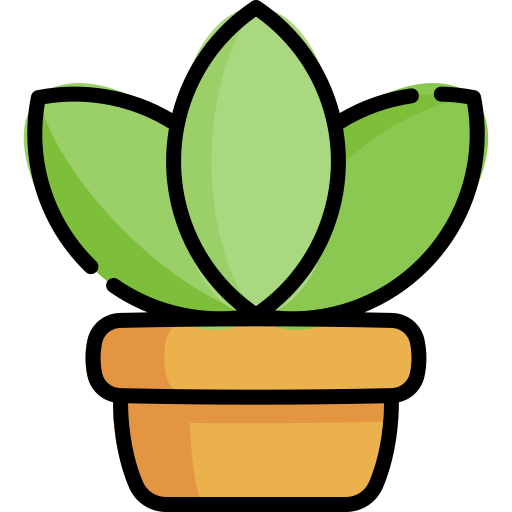Orchids bring a touch of exotic elegance to any home, with their intricate blooms and stunning colors. Despite their reputation for being fussy, most orchid challenges boil down to misunderstandings—especially about watering orchids the right way. Understanding how and when to water orchid plants in your care is essential for success. Unlike typical houseplants sitting in soil, most potted orchids are epiphytes, meaning they grow naturally on trees in a tropical environment, with their orchid roots exposed to the air. This unique adaptation means the approach for potted orchids is different, and the wrong watering routine can easily lead to root rot.
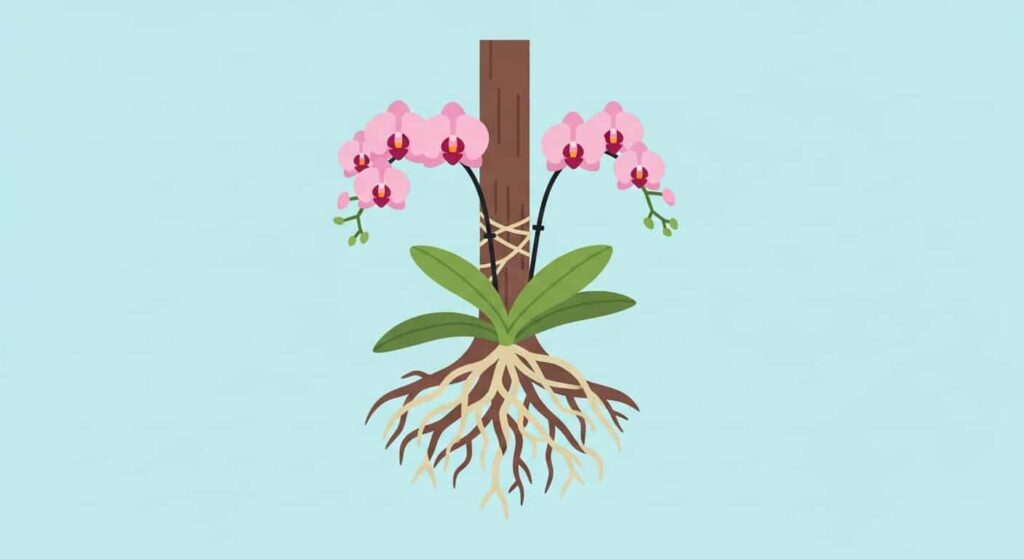
So, how often do orchids need to be watered? The most accurate answer: it depends. There’s no universal schedule, no one-size-fits-all approach. The right “time to water” is a balance shaped by your orchid’s species, its potting mix, the climate, the pot it lives in, and even the season. In this guide, you’ll learn how to optimize water for orchids of all kinds, discover signs to watch for, and develop a routine that keeps your plants thriving.
Understanding the Factors That Influence Orchid Watering
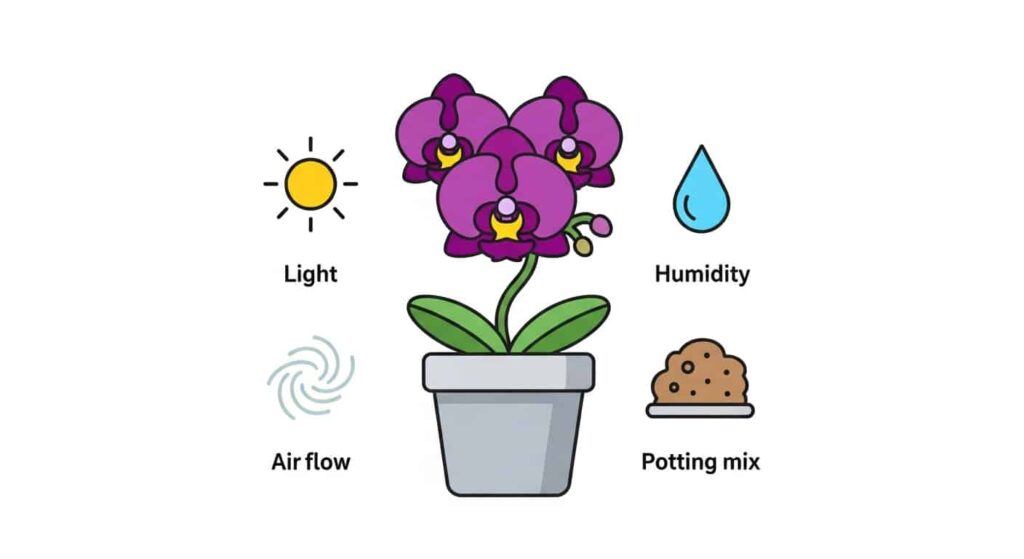
Creating a successful watering routine for potted orchids starts with understanding all the factors at play. Several key aspects determine how quickly your orchid will absorb water and when it’s the perfect time to water again.
The Type of Orchid Matters Most
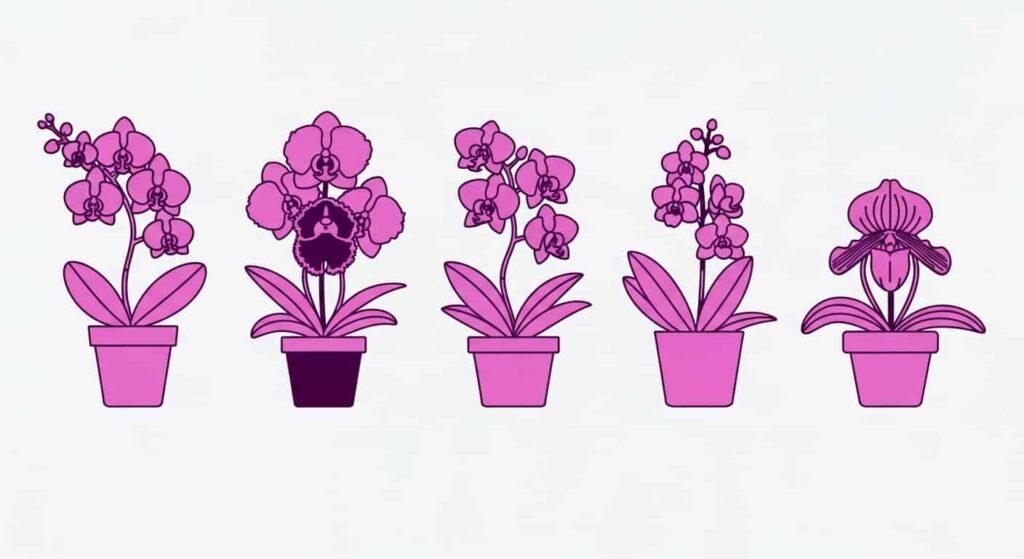
The Orchidaceae family is huge, with more than 28,000 species. While many commonly grown potted orchids sold in stores have similar needs, getting familiar with the differences is a good idea before you set your routine.
- Phalaenopsis (Moth Orchids): The most popular potted orchids, they like their potting mix to dry slightly between waterings but not stay dry for long. Their fleshy leaves and roots help absorb water and store it, giving a safety cushion if you miss the right time to water.
- Cattleya: Known for large, fragrant blooms, Cattleyas use pseudobulbs to absorb water for later use. For these, let the potting mix dry out completely before watering orchids again.
- Dendrobium: Some types are deciduous, needing a dry spell in winter, while others like it more consistently moist. For the health of the orchid root system, always confirm which kind you have.
- Oncidium (Dancing Lady Orchids): These orchids have fine roots and small pseudobulbs, so they’re less tolerant of drought but also can suffer if kept too wet, which can lead to root rot. Their potting mix should be kept evenly moist.
- Paphiopedilum (Slipper Orchids): Often terrestrial, they grow in the rich soils of the forest floor in a tropical environment. Unlike epiphytes, their potting mix should remain consistently moist, as their roots can’t absorb water quickly from the air.
Your Home Environment and Climate
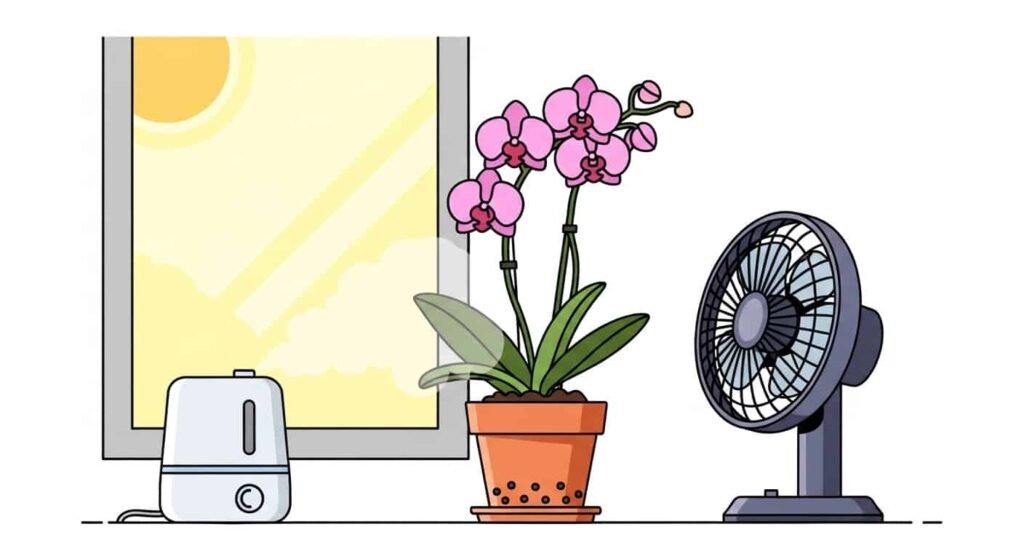
Your growing space creates a miniature ecosystem for your orchids, and it strongly impacts watering orchids successfully.
- Humidity: Native to a tropical environment, orchids love humidity. When indoor air is dry—such as during winter heating—potted orchids lose moisture faster, so you’ll need to water orchid plants more frequently.
- Temperature: Warm, sunny spots accelerate water use, so if your plant sits in a sun-bathed window, regular checks for the right time to water are a good idea.
- Airflow: Orchids thrive with good airflow, helping keep roots healthy—but if a fan or vent blows directly, it can dry out the potting mix rapidly, making it crucial to watch carefully so you know the best time to water.
The Pot and Potting Medium
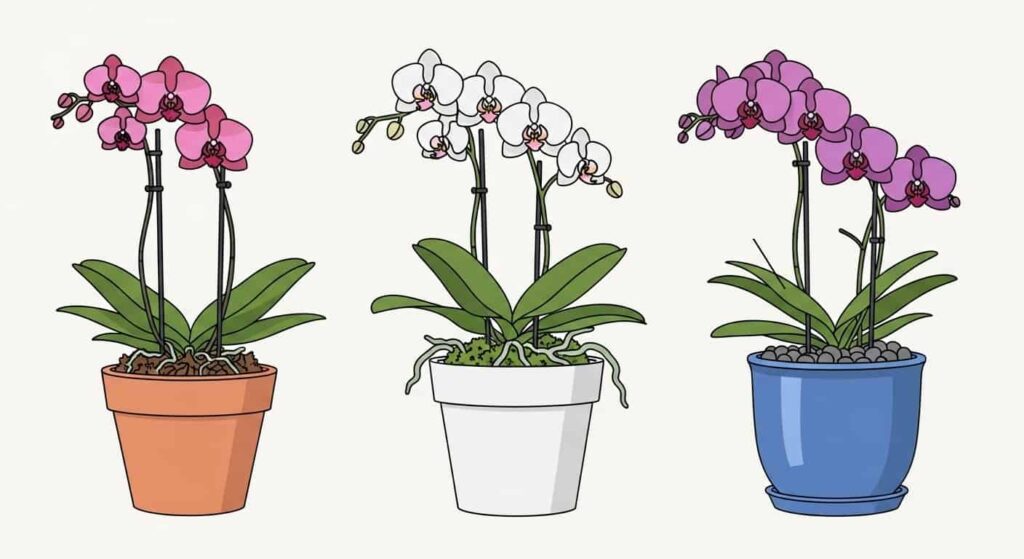
What your orchid is planted in has a defining effect on how it absorbs water. Choosing the right pot and potting mix is essential for healthy potted orchids.
- Pot Type:
- Terracotta/Clay Pots: Porous and speedy to dry, which can be a good idea for some orchid types, but means you’ll be watering orchids more often.
- Plastic or Glazed Ceramic Pots: These retain moisture longer—beneficial for potted orchids that thrive on more consistent moisture. Most commonly, orchids come in clear plastic inner pots, letting you see the state of the orchid root and when it’s time to water orchid plants again.
- Potting Mix: Avoid regular soil for orchids; instead, use specialized potting mix that promotes airflow and drainage.
- Bark Chips: The classic choice, bark chips provide plenty of space for orchid roots to breathe and absorb water. As bark ages, it holds more moisture—worth noting, as watering orchids might become less frequent over time.
- Sphagnum Moss: Holds lots of water, so it’s a good idea to ensure you don’t overdo it, as this could lead to root rot. In general, potted orchids in sphagnum may need water every two weeks or so.
- Inorganic Media: Materials like perlite, lava rock, or LECA give superb aeration, but they don’t retain much water, so you’ll notice the time to water comes around sooner.
The Impact of Seasons

Just like plants in nature, orchids change their habits with the seasons—which affects how often you’ll water orchids in your home.
- Spring and Summer (Active Growth): Longer, warmer days spur active growth. Potted orchids sprout new leaves and spikes, using more water, so watering orchids every 7–10 days is often needed.
- Fall and Winter (Rest Period): Growth slows, orchids rest, and their need for water drops sharply. You might find water for orchids is only needed every 2–3 weeks in these months. Sticking to a summer schedule in winter can easily lead to root rot.
General Guidelines for How Often to Water Your Orchid
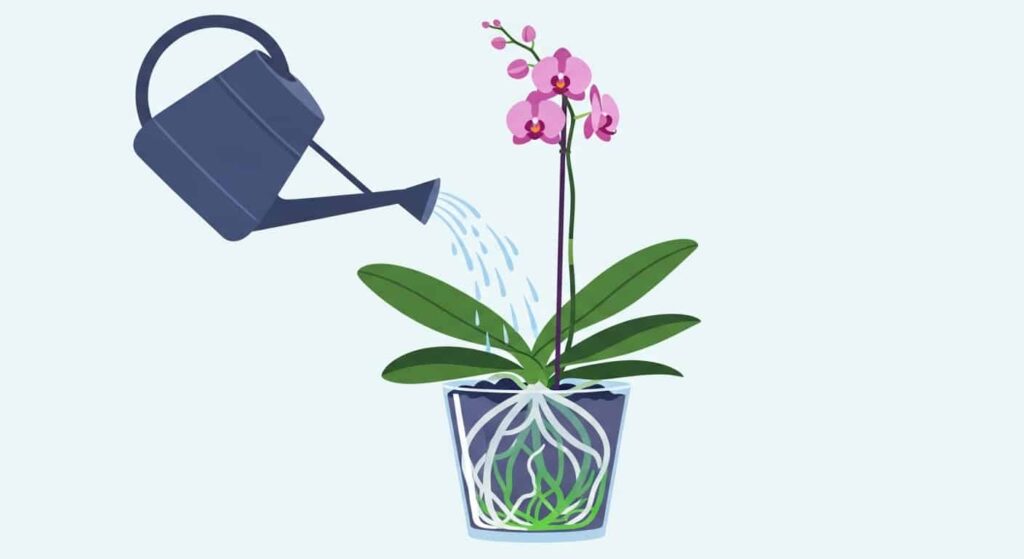
Rather than just marking your calendar, learn your orchid’s natural rhythms. For the popular Phalaenopsis and many other potted orchids, a general rule is to water every 7–10 days. But always check before adding water for orchids—each situation is unique.
The Best Way to Check: Look and Feel

Replace guesswork with observation to find the true time to water.
- Check the Potting Mix: Insert your finger or a wooden stick into the potting mix. If it comes out damp, wait; if dry, it’s time to water orchid plants.
- Observe the Orchid Roots: With clear pots, you can see if roots are green (hydrated) or silvery/white (dry). Silvery roots signal it’s time to water.
- Weigh the Pot: Right after watering, lift the pot to feel its heft. As the potting mix dries, it gets much lighter—a reliable trick to know when to add water for orchids.
Danger Signs: Overwatering vs. Underwatering
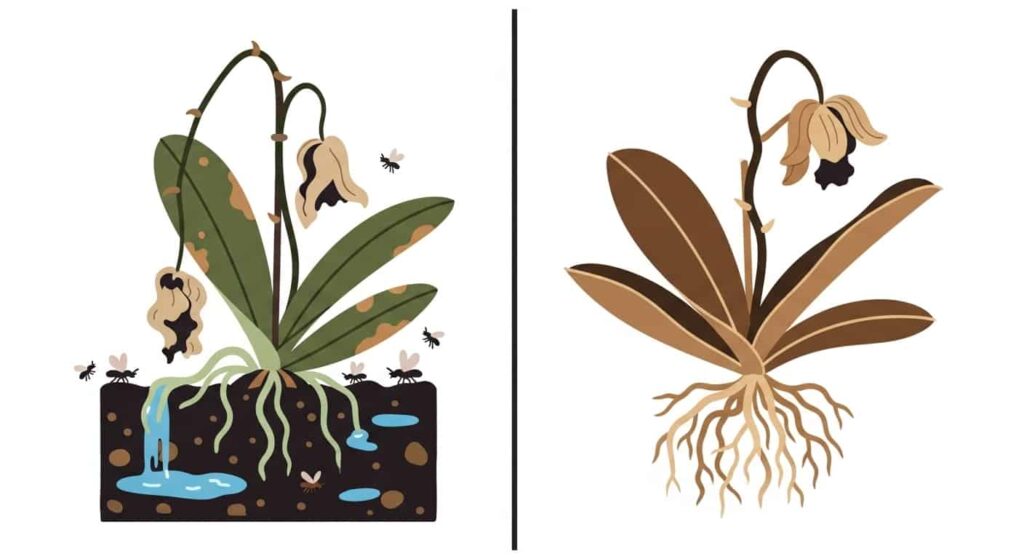
A successful orchid routine depends on avoiding two pitfalls: overwatering (which can lead to root rot) and underwatering.
Signs of Overwatering
- Mushy, Brown, or Black Roots: Healthy orchid root systems are firm and green or white. Soft, dark roots mean too much water—a common culprit when potted orchids sit in soggy mix or lack drainage.
- Yellowing Leaves and Wilting: If roots rot and can’t absorb water, leaves wilt even as the potting mix seems wet.
- Fungus Gnats or Moldy Smell: Persistently damp environments invite pests and fungus, confirming that your watering orchids schedule is too generous.
- Bud Blast: Buds turn yellow and fall off prematurely—often caused by root damage due to inconsistent or improper watering.
How to Fix Overwatering: Hold off watering, remove the orchid from its pot, and cut away all dead or mushy roots. Repot using fresh, dry potting mix suitable for your orchid type. Make sure there’s excellent drainage and avoid letting water sit at the base, as this can lead to root rot.
Signs of Underwatering
- Wrinkled, Leathery Leaves: Leaves on thirsty potted orchids become limp and textured.
- Silvery-White, Brittle Roots: Dry orchid roots take on a papery, shriveled look, showing they can’t absorb water effectively.
- Shriveled Pseudobulbs: Especially common for certain types, like Cattleyas.
- Slow Growth: Consistently missing the right time to water translates to stunted leaves or flower spikes.
How to Fix Underwatering: When your plant shows these signs, it’s a good idea to soak it thoroughly, following the steps below to properly water orchid plants.
Proper Watering Techniques for Healthy Orchids
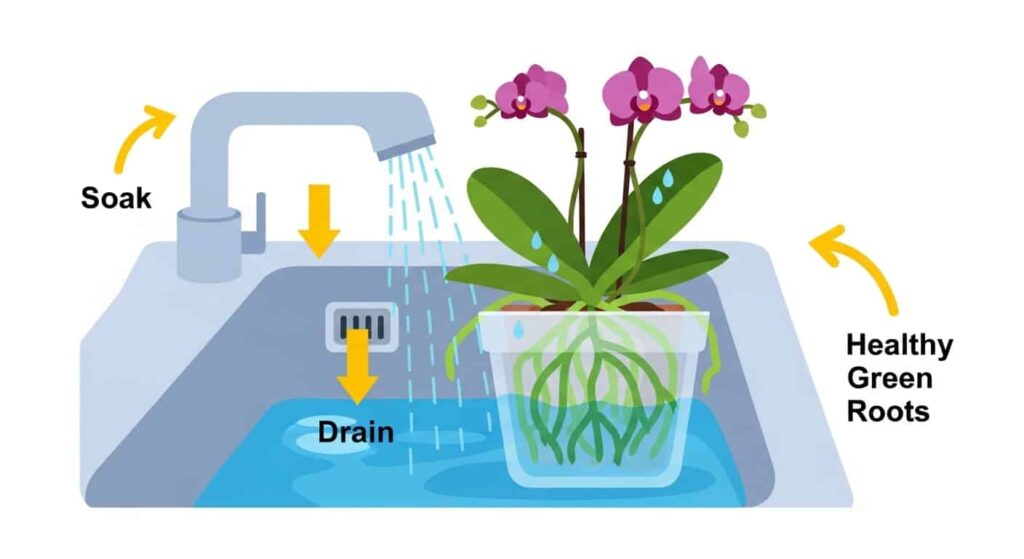
How you water is just as important as how often. A quick splash is rarely enough—here’s how to help your potting mix and orchid root absorb water well:
The Soaking Method
This is the gold standard for watering orchids grown in bark-based potting mix:
- Prepare Water for Orchids: Use lukewarm, non-softened water. If possible, use rainwater or filtered tap water—orchids are sensitive to built-up minerals.
- Transport to Sink: Place your potted orchids, still in their liner pots, in the sink to promote free drainage.
- Saturate the Potting Mix: Pour water over the entire mix for a minute or two. Avoid letting water pool in the crown, since standing moisture can lead to root rot.
- Optional Soak: For extra-thirsty orchids, let the pot sit in a shallow water bath for 10–20 minutes. This ensures bark and roots truly absorb water.
- Drain Well: Never skip this step! Let the pot sit in the sink until it stops dripping. Returning damp pots to decorative containers too soon is a quick path to root rot.
Tips for Watering with Sphagnum Moss
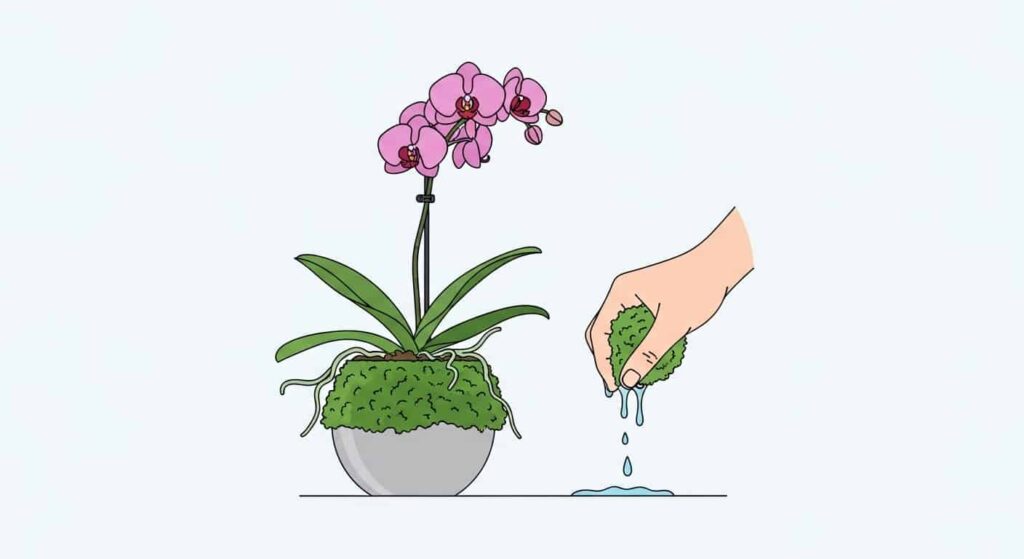
Orchids in moss need more careful attention. Only add water when the moss is nearly dry at the surface. It’s a good idea to squeeze excess water out gently after watering orchids in moss, so the roots can still breathe and don’t sit in soggy media.
Fertilizing and Other Care Considerations
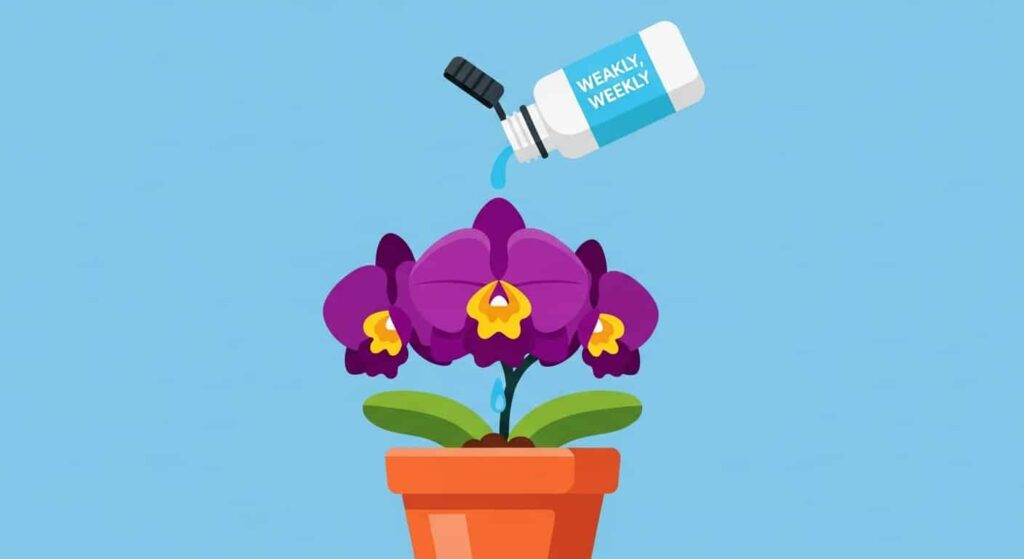
Healthy potted orchids also benefit from a regular feeding routine during active growth. A diluted, orchid-specific fertilizer is typically best—consider a “weakly, weekly” approach (use fertilizer every other watering). In winter, reduce or pause feeding, since growth slows.
Conclusion: Become an Orchid Watering Expert
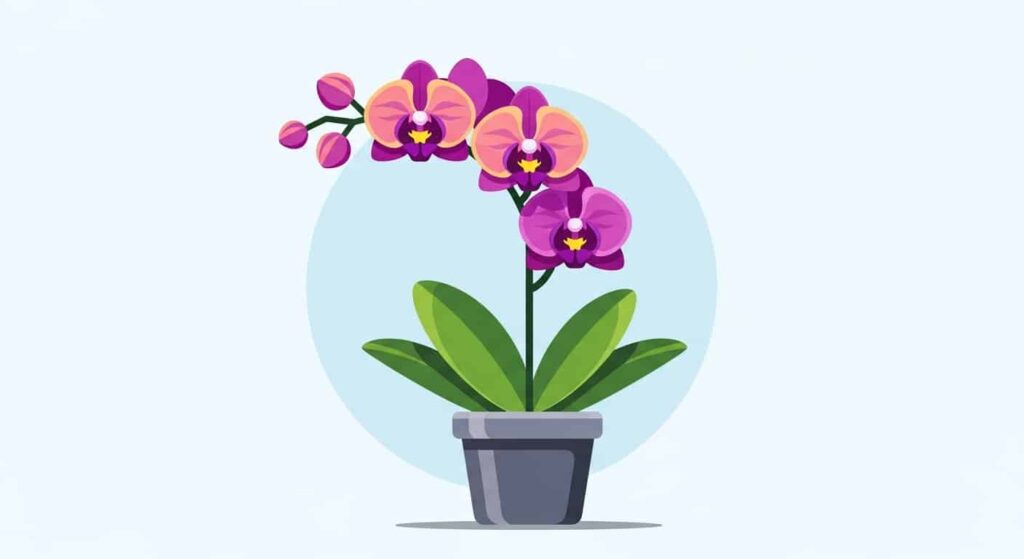
Mastering how often to water orchid plants hinges on observation, a well-chosen potting mix, and understanding the needs of potted orchids in a non-tropical environment. Remember: let the mix dry out a little, watch your orchid root color, and always opt for a thorough soak over a sprinkle. It’s a good idea to take note of your climate and growing space, since even small changes can affect how quickly your potting mix and roots absorb water.
With a bit of practice, you’ll not only prevent mistakes that lead to root rot but also encourage healthy blooms year after year. Watering orchids doesn’t have to be mysterious—just attentive, informed, and consistent. With the right approach, you’ll keep your orchid vibrant and beautiful for seasons to come.
